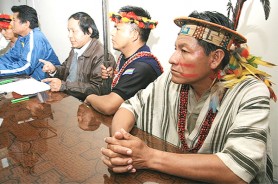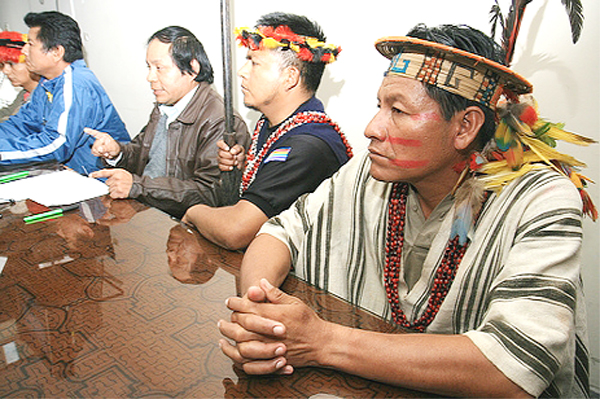The Struggle for the Amazon: A Struggle for Us All
This week’s column has tremendous relevance for us in Guyana, for it is about the Amazonian rainforests increasingly being seen as a resource to be exploited, and about the potentially devastating implications for Amerindian communities, the Amazon’s original caretakers, and for us all if the forests are threatened. In Peru, opening up the Amazon Basin to large-scale investment in mining, oil drilling, logging and farming was set in motion by decrees issued by President Alan García to implement the country’s free trade agreement with the United States, resulting in protests that erupted last week into violent clashes with police. Carmen Vildoso, Peru’s Women’s Affairs Minister, resigned in protest over the government crackdown. The Peruvian government issued a warrant for the arrest of indigenous activist and protest leader Alberto Pizango, who was granted political asylum by Nicaragua. Last Wednesday, the Peruvian legislature agreed to suspend – but not completely revoke – decree 1090. The protests are continuing.

Thanks to Marisol de la Cadena, a Peruvian anthropologist who teaches in the US, for sending the English version of the statement below that details the events and asks for letters of support, and Ben Powless, who is Mohawk from Six Nations in Ontario (Canada) and is currently in the Peruvian Amazon, for supplying the photograph.
On the dawn of June 5, 2009, a violent confrontation began between Peruvian police forces and a large group of Awajún indigenous people. The police’s objective was to break up a blockade of the Fernando Belaúnde Terry Highway in a section known as “Devil’s Curve,” near the town of Bagua in the northern Amazonian lowlands of Peru. The Awajún-Huambisa had taken control of this highway as part of a general strike organized by indigenous groups in the Peruvian Amazon basin starting April 9. This strike was peaceful and massive. It had the support of the non-indigenous inhabitants of the Amazonian rainforest all the way from the Colombian to the Bolivian borders with Peru. The strike was organized primarily to protest the recently approved Legislative Decree 1090 as well as legislative decrees 1020, 1084, 1069, promulgated by the Alan Garcia government of Peru to facilitate “the development of extractive industries” (oil, other minerals, and bio-fuels) on territories that are inhabited by dozens of indigenous groups as well as non-indigenous people who use this land for fishing, agriculture, and hunting and gathering. The inhabitants of the Amazon region were protesting not only the transformation and eventual destruction of their resources and their way of life but also the unconstitutionality of D.L. 1090 and the other decrees which violate the ILO’s “Convention (169) Concerning Indigenous and Tribal Peoples in Independent Countries.” This convention was signed by the Peruvian government and has constitutional status. It requires that indigenous peoples must be consulted on all changes relating to the lands they inhabit. Since no such consultations took place, the protesters considered these decrees unconstitutional and that therefore, they had the legitimate right to protest against them.
For more than 50 days, demonstrations and protests in the Amazon region were both massive and peaceful. They represented citizens’ lawful exercise of their rights to denounce the unconstitutionality of decrees that violate an international accord. Indigenous people were asking their own government to respect its own laws. In addition to peaceful protests in the Amazon region, indigenous leaders also took other highly visible actions to achieve their goals legally, asking the Peruvian Congress to debate the decrees as a first step to their repeal. In addition, indigenous people sent numerous requests for dialogue to Garcia administration, all of which were ignored as were similar requests from the Catholic bishops of the Amazon and the Peruvian Episcopal Conference. Instead, the government responded in an authoritarian manner. On May 9, it declared states of emergency in various cities in the Amazon basin. The government ignored indigenous people’s right to be heard just as any other citizens and instead argued that the indigenous people were being “manipulated.” Racist terminology was employed to discredit indigenous demands. On Thursday, June 4, when the Ombudsman’s Office (an official entity of the Peruvian government) had already submitted a complaint of unconstitutionality in reference to D.L. 1090, the Peruvian Congress definitively rejected any debate on the unconstitutionality of the law. Thus the Peruvian government not only ignored the protests of indigenous people but also repudiated the Peruvian constitution. The next day, Friday, June 5, the police forces initiated their operation to unblock the road by force and what had been a peaceful protest turned into a violent confrontation. As of June 11, no precise information was available on exactly what happened. It is not known how many people died – some sources quote the number as almost 100 while the most conservative estimate is 33. There were over 100 people injured. The victims include indigenous people and others, police and civilians. It is unclear who started shooting first. The official version states that it was the protestors while indigenous people say they had no firearms.
However, the issue is not who fired the first shot on June 5th. The issue is the violence that ensued and the deaths and injuries that resulted. It was the responsibility of the government to do everything possible to avoid violence. Those responsible for the deaths and violence are those in the government who decided to violate the Constitution, those who could have avoided violence by choosing democratic dialogue rather than authoritarianism. The responsibility for the deaths that have occurred since June 5 should be assumed by those who ignored repeated requests to comply with the Peruvian Constitution that indigenous citizens peacefully presented to the Peruvian government for more than fifty days. The government’s obstinate violation of the Constitution led to the violation of the human rights of civilians and police officers who fell victim to the violence that a responsible government, respectful of the rule of law, could have avoided.
Therefore, we strongly urge the Peruvian government and all of its institutions to:
a) Respect and fully implement ILO Convention 169, of which Peru is a signatory, and repeal the unconstitutional legislative decrees;
b) Respect and fully implement the UN Declaration on Indigenous Peoples’ Rights, of which Peru is a signatory, and in particular the right to free, informed and previous consent and the right to the land and use of natural resources (Articles 26, 29, 32, and others);
c) Comply with the decisions and jurisprudence of the Inter-American Court of Human Rights relating to indigenous peoples’ rights to land and free, previous, and informed consent;
d) Lift the states of emergency in the areas affected by the recent violence and halt the militarization of this area, assuring that all the rights of the residents are respected.
e) Guarantee respect for all human and civil rights and arrange for an international presence to facilitate peaceful negotiations with the indigenous people of the Peruvian Amazon lowlands;
f) Cease all political persecution of indigenous politicians;
g) Carry out an independent investigation of the June violence and its antecedents and assure accountability by all those responsible. President Garcia and his ministers should be called upon to explain why they refused to engage in dialogue with Amazonian indigenous people despite repeated requests and despite the fact that they repeatedly engaged in dialogue with residents of other regions of Peru and opted for a police action instead. Congress should also explain why it refused to debate the legislative decrees the day before the police operation.
To sign this statement, please send an e-mail with your name and nationality to pronunciamientoamazonia@gmail.com

